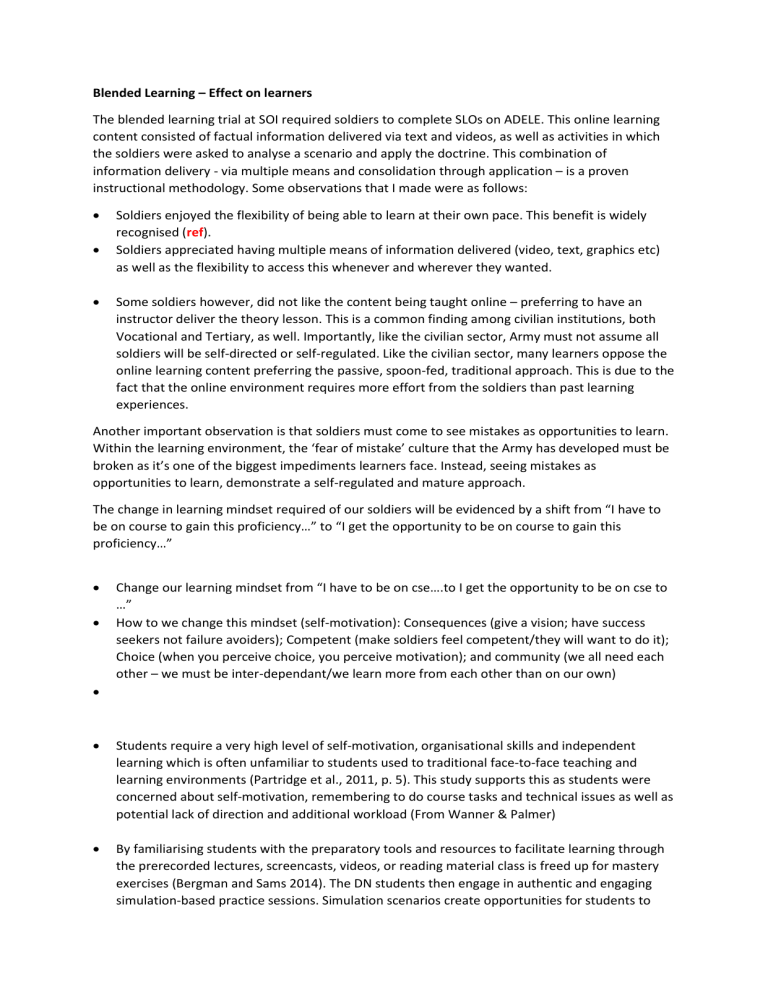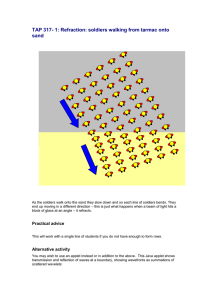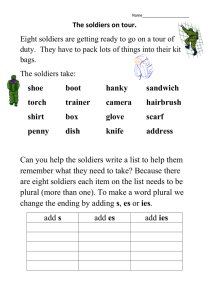
Blended Learning – Effect on learners The blended learning trial at SOI required soldiers to complete SLOs on ADELE. This online learning content consisted of factual information delivered via text and videos, as well as activities in which the soldiers were asked to analyse a scenario and apply the doctrine. This combination of information delivery - via multiple means and consolidation through application – is a proven instructional methodology. Some observations that I made were as follows: Soldiers enjoyed the flexibility of being able to learn at their own pace. This benefit is widely recognised (ref). Soldiers appreciated having multiple means of information delivered (video, text, graphics etc) as well as the flexibility to access this whenever and wherever they wanted. Some soldiers however, did not like the content being taught online – preferring to have an instructor deliver the theory lesson. This is a common finding among civilian institutions, both Vocational and Tertiary, as well. Importantly, like the civilian sector, Army must not assume all soldiers will be self-directed or self-regulated. Like the civilian sector, many learners oppose the online learning content preferring the passive, spoon-fed, traditional approach. This is due to the fact that the online environment requires more effort from the soldiers than past learning experiences. Another important observation is that soldiers must come to see mistakes as opportunities to learn. Within the learning environment, the ‘fear of mistake’ culture that the Army has developed must be broken as it’s one of the biggest impediments learners face. Instead, seeing mistakes as opportunities to learn, demonstrate a self-regulated and mature approach. The change in learning mindset required of our soldiers will be evidenced by a shift from “I have to be on course to gain this proficiency…” to “I get the opportunity to be on course to gain this proficiency…” Change our learning mindset from “I have to be on cse….to I get the opportunity to be on cse to …” How to we change this mindset (self-motivation): Consequences (give a vision; have success seekers not failure avoiders); Competent (make soldiers feel competent/they will want to do it); Choice (when you perceive choice, you perceive motivation); and community (we all need each other – we must be inter-dependant/we learn more from each other than on our own) Students require a very high level of self-motivation, organisational skills and independent learning which is often unfamiliar to students used to traditional face-to-face teaching and learning environments (Partridge et al., 2011, p. 5). This study supports this as students were concerned about self-motivation, remembering to do course tasks and technical issues as well as potential lack of direction and additional workload (From Wanner & Palmer) By familiarising students with the preparatory tools and resources to facilitate learning through the prerecorded lectures, screencasts, videos, or reading material class is freed up for mastery exercises (Bergman and Sams 2014). The DN students then engage in authentic and engaging simulation-based practice sessions. Simulation scenarios create opportunities for students to apply and practice the knowledge gained from preparatory learning materials in a collaborative and supportive setting (Gaba 2007). Simulation sessions also have the capacity to enhance learner’s psychomotor, communication, teamwork and critical thinking skills (Lapkin et al 2010). These practice based learning simulations are designed to emphasise a problem solving, critical thinking, evidence based and reflective approach to nursing practice (Allen 2013) by drawing upon a theoretical frame of clinical reasoning However, self-directed and self-regulated learners and ‘flexible students’ are not a given as not every student is ready for, and open to, more personalised and self-regulated learning and the shift from passive, spoon-fed to active, collaborative learning students overall enjoy and want a more personalised learning approach through the flipped classroom and flexible assessment. It also shows quite strongly that many students are undecided about the merits of many facets of personalised, flexible learning and it remains to be seen where their opinions settle. students want their personalised learning not only in the form of online activities, but predominantly through interactive, collaborative, well-structured learning activities in a face-to-face environment It is clear from the findings that students liked the face-to-face interaction in the tutorials. Students require a very high level of self-motivation, organisational skills and independent learning which is often unfamiliar to students used to traditional face-to-face teaching and learning environments (Partridge et al., 2011, p. 5). This study supports this as students were concerned about self-motivation, remembering to do course tasks and technical issues as well as potential lack of direction and additional workload Wanner & Palmer 2015 The flipped classroom Flipping the nursing curriculum Dalton, Lee et al, Date… The flipped-classroom approach is an effective way of radically transforming education to produce ENs who are flexible and well-equipped to practice in dynamic health care environments (Missidline et al 2013). The ‘flipped classroom’ exposes learners to new theoretical content prior to them attending face-to-face classes (Bergman and Sams 2014). This new learning is then discussed, applied and processed in guided group learning sessions (Benitez 2014). The notion of a flipped classroom draws on constructivist learning theories and concepts such as active learning and student engagement (Bergmann and Sams 2014; Hawk 2014). Educators who use a flipped classroom approach devote much of the “face-to face” contact time to small group and class brainstorming, peer review and other epistemological processes such as wondering, critiquing, collaboration, visualisation and connection making (Ryan 2013). Students learn how to learn instead of relying on content heavy didactic approaches that encourage passive transference of knowledge (Allen 2013). There is emerging evidence that the flipped classroom pedagogical approach has the potential to bring about a distinctive shift in priorities in nursing programs from merely covering material to working towards mastery (Hawk 2014). It is suggested that flipped classrooms promote student empowerment and create opportunities to develop the skills required for the 21st century such as critical thinking, creativity, and communication (Ryan 2013) Simulation based practice sessions By familiarising students with the preparatory tools and resources to facilitate learning through the prerecorded lectures, screencasts, videos, or reading material class is freed up for mastery exercises (Bergman and Sams 2014). The DN students then engage in authentic and engaging simulationbased practice sessions. Simulation scenarios create opportunities for students to apply and practice the knowledge gained from preparatory learning materials in a collaborative and supportive setting (Gaba 2007). Simulation sessions also have the capacity to enhance learner’s psychomotor, communication, teamwork and critical thinking skills (Lapkin et al 2010). These practice based learning simulations are designed to emphasise a problem solving, critical thinking, evidence based and reflective approach to nursing practice (Allen 2013) by drawing upon a theoretical frame of clinical reasoning because the learning environment required more effort from participants than had past learning experiences, and necessarily included their having to wrestle with uncertainty in the absence of authoritative instruction, some identified the additional effort required as a significant source of resistance to active learning


